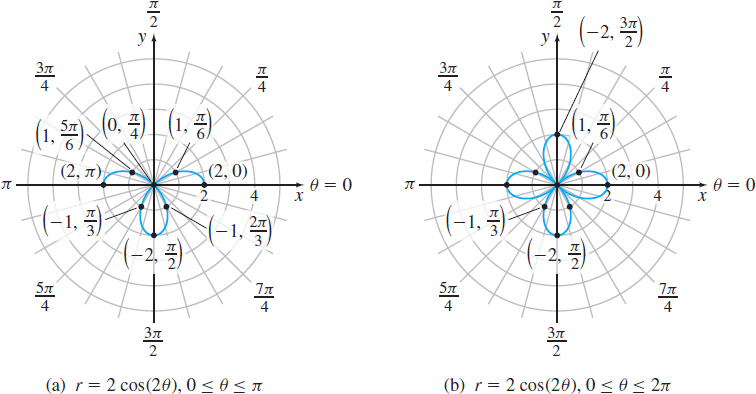EXAMPLE 4Graphing a Polar Equation (Rose); Finding Parametric Equations
(a) Graph the polar equation r=2 cos(2θ), 0≤θ≤2π.
(b) Find parametric equations for r=2 cos(2θ).
Graphs of polar equations of the form r=a cos(nθ) or r=a sin(nθ),a>0,n an integer, are called roses. If n is an even integer, the rose has 2n petals and passes through the pole 4n times. If n is an odd integer, the rose has n petals and passes through the pole 2n times.
Solution (a) The polar equation r=2 cos(2θ) contains cos(2θ), which has the period π. So, we construct Table 5 using common values of θ that range from 0 to 2π, noting that the values for π≤θ≤2π repeat the values for 0≤θ≤π. Then we plot the points (r,θ) and trace out the graph. Figure 46(a) on page 674 shows the graph from the point (2,0) to the point (2, π). Figure 46(b) completes the graph from the point (2, π) to the point (2, 2π).
| θ | r=2 cos(2θ) | (r,θ) |
|---|---|---|
| 0 | 2(1)=2 | (2,0) |
| π6 | 2(12)=1 | (1,π6) |
| π4 | 2(0)=0 | (0,π4) |
| π3 | 2(−12)=−1 | (−1,π3) |
| π2 | 2(−1)=−2 | (−2,π2) |
| 2π3 | 2(−12)=−1 | (−1,2π3) |
| 3π4 | 2(0)=0 | (0,3π4) |
| 5π6 | 2(12)=1 | (1,5π6) |
| π | 2(1)=2 | (2, π) |
| 7π6 | 2(12)=1 | (1,7π6) |
| 5π4 | 2(0)=0 | (0,5π4) |
| 4π3 | 2(−12)=−1 | (−1,4π3) |
| 3π2 | 2(−1)=−2 | (−2,3π2) |
| 5π3 | 2(−12)=−1 | (−1,5π3) |
| 7π4 | 2(0)=0 | (0,7π4) |
| 11π6 | 2(12)=1 | (1,11π6) |
| 2π | 2(1)=2 | (2, 2π) |

(b) Parametric equations for r=2 cos(2θ): x=r cosθ=2 cos(2θ) cosθy=r sinθ=2 cos(2θ) sinθ
where θ is the parameter, and if 0≤θ≤2π, then the graph is traced out exactly once in the counterclockwise direction.